>>1.Basics and rules >>1.2.Equipment and rules >>1.2.1.Gateball equipment(prev|next)
Gateball equipment
To play gateball, you have to understand the basic structure of the game first. In this article, I'm going to explain what kind of equipment is required. Then I'm writing about basic rules in the following 6 articles. To help your understanding the article below, I will show you the shortest but imperfect summary. The purpose of the game is to gain more points than the opponent team within 30 minutes. After you have learned the hardware (equipment) and software (rules), you can begin playing gateball right now.
The three sacred treasures (gates, balls, mallets) + accessories
The three sacred treasures are Japanese mythtic items which belong to the Imperial family of Japan. In the original context, they are mirror, sword and jewels and that term is often used to describe something indispensable to what you are going to talk about. In the context of gateball, they should be gates, balls and mallets to strike the ball with. Although they are not sacred at all, they are absolutely necessary for playing gateball.
If you play on the fixed court, those three are all what you need, otherwise you need a special court tape, U-shaped nails with which you fix the tape and measure to arrange gates at the appropriate positions. All items mentioned so far are a minimal set for playing gateball. There are accessory items to help your play such as a score counter or bibs. You can buy gates and balls and a court tape for less than $200. Mallets can be costly if you want high-end model but average mallets cost $100-150 in Japan. Chinese manufacturers provide the cheaper mallets. If your budget is limited, it is a good alternative choice.

Minimal set for playing gateball (brand new court tape, U-shaped nails, 10 balls, three gates and one goal-pole)

Digital score counter: You can record ten balls' score and how many minutes to go. Toku-ten-o (Nichiyo)
- Gates, balls and mallets are three indispensable items for playing gateball.
- If you have to set your court, you need a special court tape and U-shaped nails to fix it.
The court
The gateball court consists of two parts, the inner-field and the outer-field. The inner-field is rectangular in shape, 15 meters in length and 20 meters in width. The inner-field is the place in which almost all plays occur during the game. It is sometimes simply called 'court' for this reason. The inner-field is bounded by the inside line and it is surrounded by the outer-field. The width of the outer-field is 50-100 centimeters. The rulebook says the surface of the court shall be flat and clear of any obstacles. There are many court types, lawn, artificial lawn and clay as shown in the picture below. You can choose any of them.
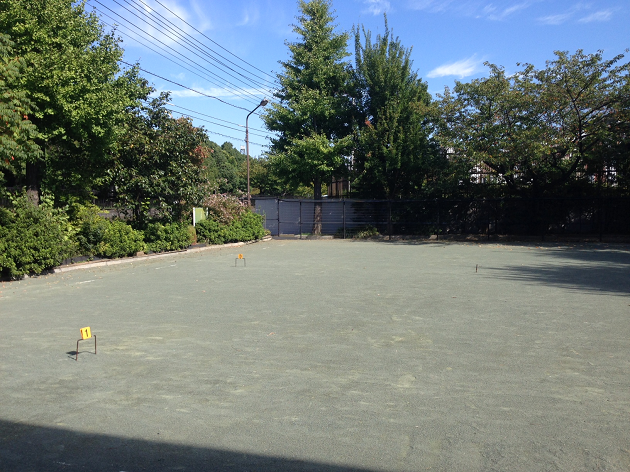
Typical gateball court (Toyozumi gateball court, Tokyo)
The three gates and one goal-pole are arranged in the inner-field as shown in the figure below. It is proportional to the original scale except for the goal-pole. Each gate has its own number from one to three and called the first, second and third gate, respectively (or just gate 1, 2 or 3). The inner width of the gate is 22 centimeters and the height is 19 centimeters. All gates should be vertical.
There is a two centimeter-wide goal-pole in the center of the court. As its name suggests, if your ball hits the goal-pole after you have passed all three gates, your ball will make an "agari (finishing)" (agari is a Japanese word for finishing in a board game.). The arrangement of the gates and a pole is very important. I will explain how you can gain points with them later.
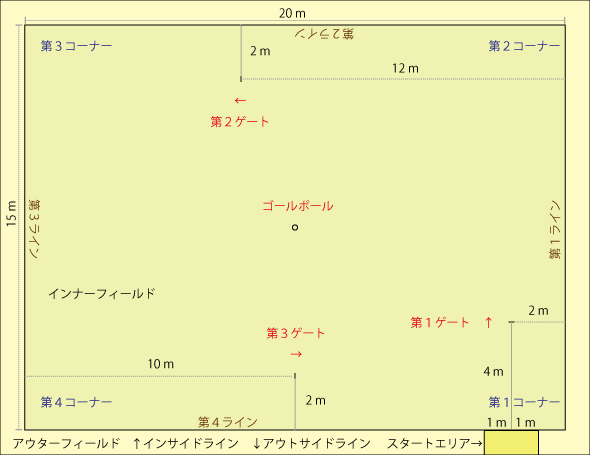
The gateball court: There are three gates and one goal-pole in the court. The goal-pole is located in the center of the court. The three gates are set paralel to the inside line as shown. The arrows near the gates represent the direction of passing them.

Gates and a goal-pole: All gates and a goal-pole should be firmly fixed. Square indicators should be attached to the gates so that players can recognize them easily.
Each gate has the direction of passing as shown in the figure above. The side from which you can "pass" the gate is called the front side. The other side is called the back side. Although you can make your ball physically pass the gate from the back side, that is not a scoring play. Each corner or line also has the name. The corner nearest to the first gate is the first corner. The other three corners called the second, third or fourth corner are followed in an anticlockwise direction. The four inside-lines are named in the same way. These "technical terms" are very important when we discuss the strategy.
- The gateball court is a 15 m x 20 m rectangle. It has three gates and one goal-pole.
- The three gates are numbered from one to three and they are called the first, second and third gate, or simply gate 1, 2 and 3.
- After having passed all three gates in the right direction in the right order, that ball can make an agari by hitting the goal-pole.
- All four lines and four corners also have their own names.
The balls
You need ten balls to play gateball. Each ball has its own number on the surface from one to ten. Odd-numbered balls (1, 3, 5, 7, 9) are red balls and even-numbered balls (2, 4, 6, 8, 10) are white balls. The color of the number is white in red balls, red in white balls. The balls are made of ABS resin, 7.5 cm in diameter, 230 g in weight. The width of the gate is almost three times as wide as that of the ball.
Gateball is a team sport. If one side plays red, the other plays white. The five players on the same team strike the five balls same in color. Each player has his/her own number. You cannot strike your teammates' balls just because they are same in color. If your number is X, all you can do during the game is to strike a ball X. In gateball, you decide the winner by comparing the sum of five balls' score on both sides. The balls are numbered not only to distinguish themselves but also to show their playing order. That playing order has very profounding influence over strategy.


The balls are 7.5 cm in diameter, 230 g in weight. Odd-numbered balls are red and even-numbered balls are white.
- You need ten balls to play gateball. Ten balls are numbered from 1 to 10.
- Odd-numbered balls (1, 3, 5, 7, 9) are red. Even-numbered balls (2, 4, 6, 8, 10) are white. Red balls have white numbers on their surface and white balls have red numbers.
- One side plays the five balls same in color.
- Gates are three times as wide as balls.
The mallets
In Japan, the mallets are called "sticks" for some historical reasons. Mallets must be the appropriate term for describing these hammer-shaped objects, so hereafter I call them mallets. Unlike other items, mallets belong to players. You can use your favorite mallet as long as it doesn't violate the rules. A mallet is divided into two parts, head and shaft. The head is cylindrical in principle, 35-50 mm in diameter and 18-24 cm in length. Japanese manufacturers provide heads following those rules. Where the rules about the shapes of the head are not very strict, for example in China, they sell square-shaped heads, but the length and the diameter must be within the limits even in those regions.
Although the weight is not limited, most players tend to use 400-500 g heads. That value was heuristically determined by many gateball players in the past. If you don't have any theory or faith against it, just obey it. Notice that the weight is not optimized for the center-stanced players. In general, the head less than 400 g in weight is not recommended because you have to strike the ball really hard. My suggestion is to use between 430-480 g.
The diameter of the head affects the accuracy of hitting the ball. The larger the diameter is, the bigger the sweet spot is. If you are not confident about your hitting accuracy, use a thicker (large diameter) head. Using a thicker head has some drawback. You may feel it difficult to know where the head is facing. Most Japanese players use 45 mm heads, some use 40 mm or 50 mm and few use less than 40 mm. In my humble opinion, the optimal diameter is 43-45 mm.
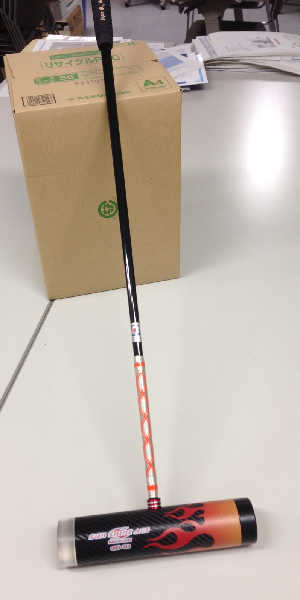
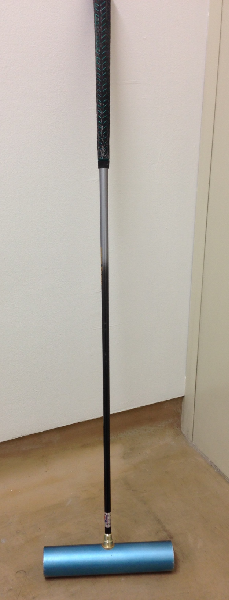
Example of gateball mallets (mine). Gateball mallets are basically hammer-shaped. The lower part is called a head and the upper part with grip is called a shaft. As you know from the picture, the design of mallets is highly variable.
The head is further divided into sub-regions. The both ends of the head with which it contacts the ball are called faces. The materials of the faces dramatically affects the feeling of hitting balls, so it is extremely important to know what your head's face is made of. Unlike in golf, hitting the ball far away is not very valuable in gateball. Most Japanese skillful players like to use softer materials because the contact time between the head and the ball is longer. The longer contact time means the better direction accuracy. If the contact time is long, your ball more faithfully copies the trajectory of your swing. Common soft materials are DURACOM, MC nylon, polycarbonate and reinforced wood. Common hard materials are aluminum alloy, stainless steel and titanium.
There is a good thing about hard materials. Metal heads are durable. In addition, due to its hardness, old players can save power to hit the ball compared to softer materials. The most important thing when you decide the materials of your faces is to try each of them and choose what you liked. As shown in the pictures above, you can buy a reversible head with two different faces.

Regulations about mallet size and shape
The other important part is a shaft. Choosing a shaft is as important as or even more important than choosing the head. Currently, carbon shafts are best-selling. They are soft and bent during the swing. The feeling of striking the ball is tender. You can make a long-distance shot easily. Carbon shaft are typical soft shafts.
Steel shafts are typical hard shafts. The feeling of striking the ball is harder and if you want to send the ball far away you need to strike it hard. It doesn't bend during the swing. Are carbon shafts better than steel shafts? Not necessarily. Soft shafts tend to twist around its long axis. If you can always hit the ball at the center of the head, no problem. In reality, even the best players sometimes strike the ball slightly off the center of the head. In that case, the torque around the shaft axis is generated. If the material of the shaft is soft, it tends to twist more. The result is that your ball more easily goes off the course which you intended. To summarize, when using soft shafts you have to be always careful for striking the ball at the center of the head, they are for experts.
As for hard shafts such as steel shafts, the stiffness around the shaft axis is larger. Even if you strike the ball off the center of the head, the ball deviates less. I am not very confident about my skill and that's why I use stiffer shafts. Recently sunshine ace developed totally new class of shafts wrapped carbon shafts. Although I don't know technical details, they say they could overcome the undesired softness around shaft axis by wrapping the lower end of the shaft with sheet. The wrapped shaft retains the original carbon shaft's flexibility along its axis and could increase the stiffness around it. Those wrapped shafts are getting more and more popular. By the way, how can you choose your shafts? Try and choose what you like. I prefer stiffer shafts theoretically, though.

Bending: Bending should be best defined as the downward deviation from the imaginary rigid mallet measured at the head, when you hold the grip of the mallet and place the shaft paralel to the ground. In real swing, bending angle theta can be defined as the angle between the grip and the shaft at the bottom. Theta is not a good index for stiffness, because it depends on how you swing the mallet. If you swing two mallets exactly the same way, the softer the shaft is, the theta is bigger. The faster you swing, the shaft bends more.
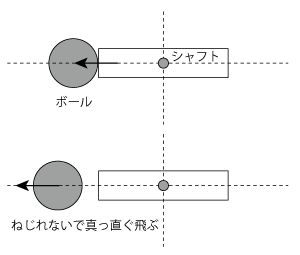

Twisting: If you can strike the ball at the center of the head, there is no torque around the shaft. If you hit the ball off the center, the torque to twist the shaft around its axis is generated as shown in the right figure. The ball deviates from the course you intended. Define the angle between the original orientation of the head and after hitting the ball as twist angle theta. Imagine that head speed is equal, if your hitting point is more deviated from the center, theta is larger. If the hitting point is the same, the faster the head speed is theta is larger. In general, hard shafts along its long axis also tend to be stiff around it. The design that increase the rotational moment (like weighted at both ends) around the shaft prevents the shaft from twisting.
After you have decided the material of the shaft, you need to adjust its length. For side-stanced players, about a half of your height is optimal. Shorter shafts make you strike the center of the ball easily, because the distance between the ball and your eyes is shorter. You can see the contact point better. Longer shafts are suitable for players with stiff backs. They can amplify the small movement at your hand better than shorter shafts. That means you need less power to strike the ball. For center-stanced players, longer shafts are suitable. As in the case in choosing heads, try and choose what you like. Other options are telescopic mallets. You can change the length of the shaft as you want. They are easy to have with. Telescopic shafts are especially suitable for the beginners or kids. The beginners tend to adjust the shaft length many times until they find their optimum. The approriate shaft length is changing as a player becomes tall.
Head done, shaft done, a mallet is almost done. You need to adjust the grip. Some players prefer ready-made grips while others wrap a grip tape for tennis or badminton over them. I usually wrap a sponge tape to make the grip thicker and then wrap a grip tape for tennis over it.
Where can you buy mallets? You can buy them online or from local shops. If you know credible local mallet sports shops, buying from them is preferable. Try and choose heads and shafts because they have many kinds of them. Feedback is also easier. If you are an expert, you can directly order the manufacturer to make your tailor-made mallet. You can have your special mallet by submitting the design pattern you want to be printed on the head.
I have used mallets from several manufacturers such as Sunshine-Sport, Murakami Mokko, TNK and Shuttle. There are many other manufacturers in Japan and in the World mainly in China. A lot of young players are using fancy mallets recently.
- A mallet is a hammer-shaped tool with which you strike a ball.
- A mallet is divided into two parts, a head and a shaft. Heads and shafts are made of various materials.
- Try and choose what you like.
